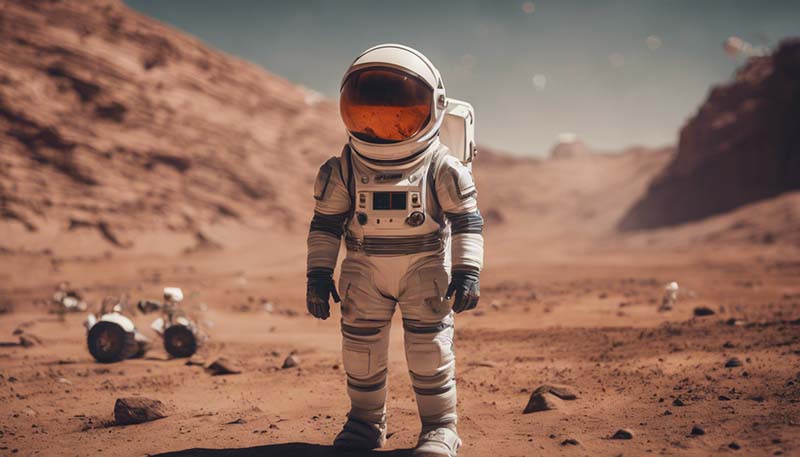Pioneering Mars: The Future of Interplanetary Travel
Introduction
As humanity continues to explore the cosmos,the idea of interplanetary travel has become increasingly relevant.Mars,the fourth planet from the Sun,has long been a subject of fascination and the focus of numerous missions,both manned and unmanned.This article delves into the future of interplanetary travel,with a particular focus on Mars,and the challenges and opportunities it presents.
The Allure of Mars
Mars,often referred to as the "Red Planet," has long captured the imagination of scientists,science fiction writers,and the general public alike.Its reddish hue,caused by iron oxide (rust) on its surface,gives it a striking appearance in the night sky.Mars is also the most Earth-like of all the planets in our solar system,with a day/night cycle close to that of Earth and a similar axial tilt,resulting in seasons.These similarities have fueled the desire to learn more about the planet and,eventually,to establish a human presence on its surface.
Past and Present Mars Missions
The first successful mission to Mars was Mariner 4,launched by NASA in 1964.Since then,numerous missions have been conducted by various space agencies,including the United States,the former Soviet Union,Europe,and India.Some of the most notable missions include the Viking 1 and 2 landers in the 1970s,which conducted extensive surveys of the Martian surface and atmosphere; the Mars Pathfinder and its rover Sojourner in 1997; and the Mars Science Laboratory and Curiosity rover in 2012.
More recently,the Perseverance rover and Ingenuity helicopter,launched in 2020,have made groundbreaking achievements in Mars exploration,including the first-ever controlled flight on another planet.These missions have significantly expanded our understanding of Mars' geology,climate,and potential habitability,bringing the prospect of interplanetary travel closer to reality.
Challenges of Mars Exploration
Despite the progress made in Mars exploration,several challenges remain.One of the primary concerns is the harsh Martian environment,which includes extreme temperatures,global dust storms,and high radiation levels.These factors pose significant risks to both human explorers and sensitive equipment.
Another challenge is the long travel time and communication latency between Earth and Mars.A journey to Mars using current propulsion technology takes approximately six to nine months,and communication delays can range from four to twenty minutes,depending on the relative positions of the two planets.This necessitates the development of advanced autonomous systems and the ability to solve problems independently on Mars.
Finally,the cost of Mars missions is a significant barrier.Space exploration is inherently expensive,and the resources required for a manned mission to Mars would be substantial.Funding and international cooperation will be crucial in overcoming this challenge and making interplanetary travel a reality.
Opportunities in Mars Exploration
Despite the challenges,Mars exploration presents numerous opportunities for scientific discovery,technological innovation,and even potential economic benefits.Studying the Martian geology,climate,and potential for past or present life can provide valuable insights into the formation and evolution of our own planet,as well as the potential for life elsewhere in the universe.
The development of new technologies for Mars exploration,such as advanced propulsion systems,life support,and in-situ resource utilization,can have broad applications beyond space exploration,benefiting industries ranging from energy to agriculture.
Furthermore,the establishment of a human presence on Mars could lead to the creation of new economic opportunities,such as space tourism,resource extraction,and even the eventual development of a space-based economy.These opportunities could drive innovation and contribute to global economic growth.
Future Mars Missions and the Path to Interplanetary Travel
The future of Mars exploration is promising,with several high-profile missions planned in the coming years.NASA's Artemis program aims to return humans to the Moon by 2024,using it as a stepping stone for a manned mission to Mars in the 2030s.Similarly,SpaceX's Starship is being developed as a reusable spacecraft capable of carrying humans to Mars and beyond.
The International Mars Sample Return mission,a collaboration between NASA and the European Space Agency (ESA),plans to collect and return samples from Mars in the next decade.This mission could provide critical information about the planet's habitability and pave the way for future manned missions.
As technology continues to advance and international cooperation grows,the prospect of interplanetary travel becomes more attainable.The journey to Mars will require significant investment,innovation,and collaboration,but the potential rewards – both scientific and economic – are immense.The future of interplanetary travel is exciting,and Mars will undoubtedly play a central role in our cosmic endeavors.
Conclusion
Pioneering Mars is an ambitious and challenging endeavor,but one that promises to expand our understanding of the universe and unlock the potential for interplanetary travel.As we continue to explore the Red Planet and push the boundaries of human achievement,we move closer to realizing the dream of a multi-planetary future.
Leave Your Comments